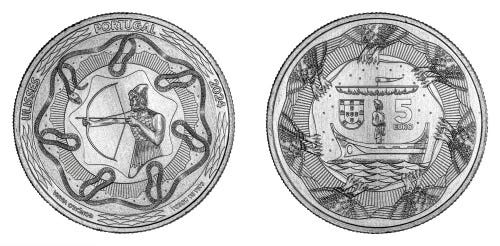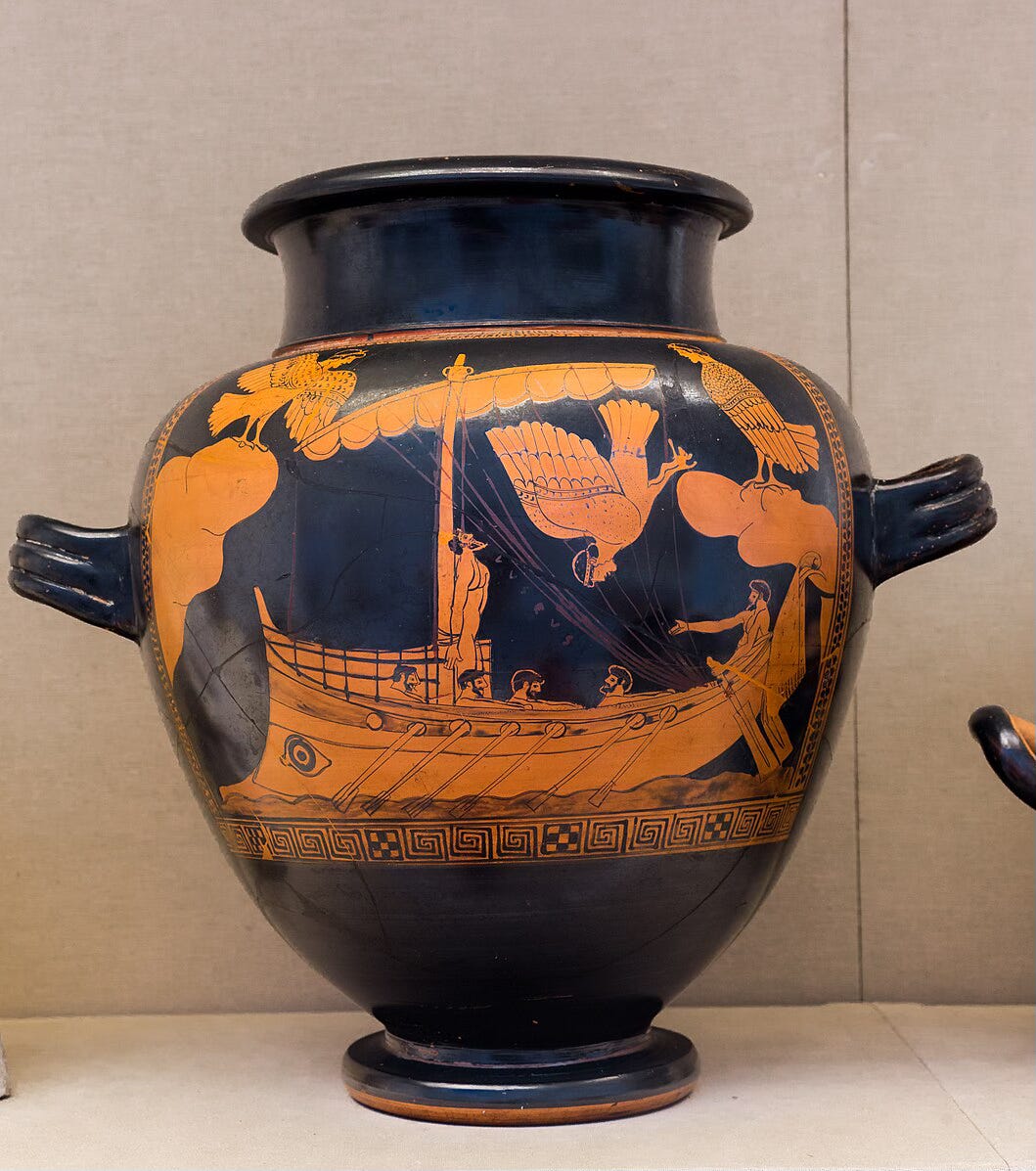
[English version below.]
Ulisses, conhecido como Odisseu na mitologia grega, é o herói épico da Odisseia de Homero. Após a Guerra de Tróia, ele enfrentou uma longa e árdua viagem de dez anos para retornar a sua casa em Ítaca. Durante essa jornada, Ulisses encontrou muitos desafios, incluindo monstros, deuses e forças da natureza, e é no contexto dessa viagem épica que surge a lenda da fundação de Lisboa.
Ulisses teria chegado às margens do rio Tejo e, encantado pela beleza do lugar, decidiu fundar uma cidade. Essa nova cidade seria chamada de Olissipo, em sua homenagem. Mas, claro, isto é apenas um mito.
A verdade é que Lisboa é habitada há milhares de anos. Primeiro, os ibéricos que viviam em pequenas povoações. Depois, os fenícios, grandes navegadores e comerciantes, estabeleceram-se na região por volta do século VIII a.C. Construíram uma cidade que chamavam de Alis Ubbo, que significa “pequeno porto encantador” ou “porto seguro”, denominação que reflete a importância estratégica da localização de Lisboa, protegida por colinas e com fácil acesso ao mar.
Com a conquista romana, a cidade passou a ser conhecida como Olissipo. Tal como os fenícios, os romanos valorizavam a localização de Lisboa como um ponto crucial para o comércio e a defesa. Olissipo tornou-se uma cidade próspera, integrando-se totalmente ao Império Romano como um municipium. Mas Lisboa e os seus arredores foram então invadidos por suevos e visigodos, passando a ser conhecida como Ulixbona.
No século VIII, com a invasão muçulmana, Lisboa recebeu o nome de Al-Ushbuna. Sob o domínio dos mouros, a cidade continuou a prosperar comercialmente e floresceu como centro cultural. A influência mourisca ainda é visível na arquitetura e na toponímia de Lisboa.
Mas o mito de Ulisses e Lisboa é mais do que uma simples história; ela é uma parte integrante da identidade cultural da cidade. Ela representa a conexão de Lisboa com o mar e com a tradição de aventura e descoberta que caracteriza a história portuguesa.
Para homenagear essa rica tapeçaria de história e mito, o Banco de Portugal emitiu, a 17 de julho, uma nova moeda comemorativa de 5 euros. A moeda apresenta Ulisses em posição de defesa com um arco e uma flecha. À volta, tem uma serpente cujo corpo desenha as sete colinas de Lisboa (tal como as sete colinas de Roma). Na outra face, o herói está amarrado ao mastro de um navio, ao lado do escudo português, e rodeado por sete sereias com corpo de ave, asas e garras, representando o episódio do herói a resistir ao canto das sereias.

O mito da fundação de Lisboa por Ulisses é uma história que entrelaça mitologia, história e identidade cultural. Ao emitir uma moeda comemorativa que celebra esse mito, Portugal reafirma a sua rica herança cultural e sua conexão com as grandes narrativas do passado.
Queres levar a tua leitura um passo adiante? Responde às perguntas abaixo ou usa as perguntas para discutir sobre o artigo com outra pessoa.
1. Quem eram os primeiros habitantes da região de Lisboa antes da chegada dos fenícios?
2. Como Lisboa foi conhecida durante o domínio romano e o que fez a cidade prosperar nessa época?
3. Quem é Ulisses na mitologia grega e qual é o seu papel na "Odisseia" de Homero?
4. Como a lenda de Ulisses e Lisboa é importante para a identidade cultural da cidade?
5. O que é que a moeda de 5 euros comemora?
Ulysses and Lisbon’s founding myth
Ulysses, known as Odysseus in Greek mythology, is the epic hero of Homer's Odyssey. After the Trojan War, he faced a long and arduous ten-year journey to return to his home in Ithaca. During this journey, Ulysses encountered many challenges, including monsters, gods and forces of nature, and it is in the context of this epic journey that the legend of the founding of Lisbon arises.
Ulysses would have arrived on the banks of the River Tagus and, enchanted by the beauty of the place, decided to found a city. This new city was named Olissipo in his honour. But, of course, this is just a myth.
The truth is that Lisbon has been inhabited for thousands of years. First, the Iberians lived in small settlements. Then the Phoenicians, great navigators and traders, settled in the region around the 8th century BC. They built a city they called Alis Ubbo, which means ‘charming little harbour’ or ‘safe harbour’, a name that reflects the strategic importance of Lisbon's location, protected by hills and with easy access to the sea.
With the Roman conquest, the city became known as Olissipo. Like the Phoenicians, the Romans valued Lisbon's location as a crucial point for trade and defence. Olissipo became a prosperous city, fully integrated into the Roman Empire as a municipium. But Lisbon and its surroundings were then invaded by Suevi and Visigoths and became known as Ulixbona.
In the 8th century, with the Muslim invasion, Lisbon was renamed Al-Ushbuna. Under Moorish rule, the city continued to prosper commercially and flourished as a cultural centre. The Moorish influence is still visible in Lisbon's architecture and place names.
But the myth of Ulysses and Lisbon is more than just a story; it is an integral part of the city's cultural identity. It represents Lisbon's connection to the sea and to the tradition of adventure and discovery that characterises Portuguese history.
To pay tribute to this rich tapestry of history and myth, the Bank of Portugal issued a new commemorative 5 euro coin on 17 July. The coin shows Ulysses in a position of defence with a bow and arrow. Around him is a serpent whose body depicts the seven hills of Lisbon (just like the seven hills of Rome). On the other side, the hero is tied to the mast of a ship, next to the Portuguese coat of arms, and surrounded by seven sirens with the body of a bird, wings, and claws, representing the episode of the hero resisting the song of the sirens.

The myth of the founding of Lisbon by Ulysses is a story that intertwines mythology, history, and cultural identity. By issuing a commemorative coin celebrating this myth, Portugal reaffirms its rich cultural heritage and its connection to the great narratives of the past.
Want to take your reading one step further? Answer the questions below or use the questions to discuss the article with someone else.
1. Who were the first inhabitants of the Lisbon region before the Phoenicians arrived?
2. How was Lisbon known during Roman rule and what made the city prosper at that time?
3. Who is Ulysses in Greek mythology and what is his role in Homer's ‘Odyssey’?
4. How is the legend of Ulysses and Lisbon important to the city's cultural identity?
5. What does the 5 euro coin commemorate?



